
If you’re the type of person who marvels at the beauty of nature, why not record your reflections in a journal? Often we think of journaling as keeping a diary of our everyday thoughts, but you can also focus a journal on one particular topic. For the nature lover, this type of journal can not only make for a relaxing pastime, but also help you create a personalized work of art that you can enjoy for many years to come.
Things you can do with a nature journal. A nature journal can be as simple or as complex as you like. Some people choose to draw things that interest them, or even attach leaves or press flowers within the pages. You might prefer to record facts on plants, animals, or fungi that you’ve researched. Or, you might be the type who is inspired to write poetry on a hike.
Gardeners also use journals to record seed starting dates, watering and fertilizing, transplanting, and more. When you adopt this habit, your journal can help you learn what works and does not work in your particular garden.
Kids can get in on the fun, too. A nature journal can become a terrific learning experience for children of all ages.
Choose a focus. You can always hone your focus as you go, but some people who journal prefer to organize their project from the start. You might wish to keep a separate journal for interesting fungi, for example, or for edible weeds found in the woods. For kids, a common and useful focus is to simply learn the leaves of trees indigenous to the area.
Gather your supplies. A blank, unlined journal is best if you intend to include drawings. Otherwise, a simple notebook with ruled pages will suffice. Remember to carry pencils or pens with you, and tape if you intend to attack leaves or other objects to your pages.
Write down questions. As you view objects in nature, ask questions that you can answer through research later.
Take photos. This can be especially important if you aren’t the most skilled artist. Including photos can help with plant identification and adds an important visual element to your journal.
Follow up later. When you research to answer questions and learn more about something you’ve seen, make sure to record your findings. Over time, your journal will serve as a living document of your life’s explorations.
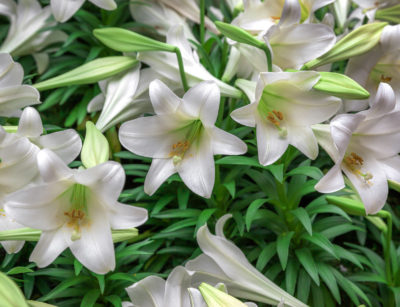
Every time another holiday rolls around, the lobby of your grocery store fills up with seasonal, decorative plants. Or perhaps you’ve been gifted with a few festive flora. But once the season has concluded, you might be wondering what to do with your potted decor. Do you hang on to decorations that don’t seem quite right for the season? Or can you plant them outside?
Yes, of course you can! But as with any other plant, you must choose the right time of year for moving your seasonal plant outdoors, and you should carefully consider where to place it in the garden.
For example, right now many of us have grown weary of our poinsettias indoors. They just scream, “Christmas”, and we’re all craving decor that feels more springlike. But you can easily replant your poinsettias outdoors, provided you consider their needs.
Keep poinsettias indoors until about late March, and then you can transplant. Cut the plant back about halfway, and then choose a sunny location in your yard with well-draining soil. Remember to keep the plant away from artificial lights, such as street lights or flood lights, at night. These can interfere with the plant’s blooming.
Surprisingly, poinsettias can actually grow to about eight feet tall and wide over time! You might wish to choose a spot that allows for this much growth, or simply keep the plant well pruned.
Soon, we will face the same situation with Easter lilies. You can plant these in your garden, too, provided you wait until the plant has finished flowering. Then, acclimate your Easter lily to natural sunlight by moving the potted plant outdoors for a few hours each day, for about two weeks.
After this time has passed (usually mid-May or so), choose a sunny spot in your garden. Amend the soil with compost or organic mulch, and then transplant the bulb about six inches deep in the soil. Place a thick (about two inches) layer of mulch around the plant to protect the roots, and water thoroughly after planting. F
Then, add a teaspoon of slow-release fertilizer to the soil around the plant about every six weeks in the summer. In the fall, the stem and foliage will turn brown. Cut off the stem just about soil level and cover with more mulch to protect the plant as it goes dormant for winter.
Always remember you can call us with any questions regarding your landscaping. We can help you design a landscape that provides seasonal color and cheer year-round, complementing any holiday decorations you decide to place in the garden.
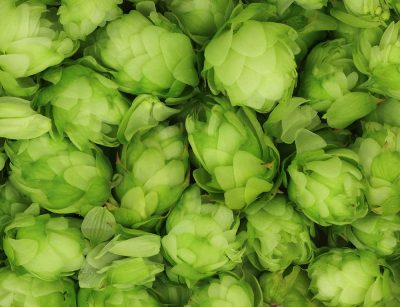
The past year has found many of us exploring new hobbies, and home brewing has surged in popularity. If you also enjoy gardening, why not combine the two pastimes and grow your own hops? That way, you can be certain of exactly what goes into your home brews and go all organic if you prefer.
First, research your hops. Hops are actually flowers that grow on bines (no, that’s not a misspelling for vines). These plants are perennial, meaning they will return year after year to bear more flowers for you. The bines are so hardy that, when well maintained, some varieties can reach 30 feet or more and collapse a trellis with the weight of their cones (what the flowers are actually called). You want to provide the ideal environment and enough space for whichever variety of hops you choose.
Now, you will purchase your rhizomes. Hops plants can be male or female, but only the females bear cones. Therefore, you want to purchase rhizomes, or underground cuttings, from female plants.
Next, choose your location carefully. Hop plants need a place to climb, such as a trellis, and they need 6-8 hours of sunlight each day. Choose a sunny spot with proper support. Luckily, because hops grow upward rather than outward, a long narrow space will do. Hops can actually serve dual purpose as a bit of a privacy barrier between neighbors with smaller yards.
Then, prepare the soil. Hops can be damaged by heavily clay soils that retain too much water. So, you want loose, well-draining soil that does not hold onto moisture. The preferred soil is slightly acidic, so keep that in mind if you amend it.
Finally, plant your rhizomes about three feet apart from one another. Remember that they spread underground, so leave them plenty of space. Bury each rhizome about two inches deep, with the bud pointing upward. Water your hops regularly, and make sure to pull any weeds that encroach into their space.
Remember that hops spend their first year establishing a root system, so you won’t see many cones at first. By the second or third year, however, you will be harvesting enough hops to throw a home brew party.

An RV can add fun and excitement to your family life, or simply provide a traveling home for single people. But more and more RV owners are looking beyond campgrounds for their RVs. Some are setting them up for part-time use at home, while others live in them full-time.
Why park at home? Yes, you originally intended your RV for traveling, but it can serve many more purposes. For example, your RV can provide extra space for…
● Outdoor parties – guests have another place to hang out (and you have an extra kitchen or bathroom to use, if you install electric and septic hookups)
● A guest quarters – now your friends and cousins have their own private retreat, they can save money, and you all get to spend more time together during visits
● A hideaway for you – if you need to work from home but need to escape the noise, just head out to your “driveway escape”
● A retreat for moody teens – sometimes teenagers just need their own spot away from everywhere else, either to work on homework or have a few friends over.
● Camp-out nights with the kids – sometimes, just doing things a little differently can make life more exciting for the little ones. Don’t forget the marshmallows!
You can probably think of even more reasons to set up your RV at home. But the bottom line is that you can expand your living space and get more use out of your investment.
Why not park at home? There’s one good reason that you shouldn’t park your RV at home. If your HOA doesn’t allow it, you could find yourself fined or at least nagged to move the vehicle. Before parking your RV, check local and neighborhood regulations.
RVs as permanent homes. With the cost of real estate skyrocketing, many individuals, couples, and even families are choosing to live in RVs full time. If you purchase land, living in the RV can keep your costs down while you pay off the loan and/or save up to build a house. Or, the RV lifestyle might be a permanent, low-overhead choice.
If you go that route, there’s a lot you can do to make your RV parking spot feel more like home. Install a permanent patio, add a picnic table, and now you can dine al fresco whenever you want. Yes, you can even landscape around your RV or plant a garden nearby. And of course, you will want a permanent electricity hookup, septic tank, and a water system.
Give us a call for more information on patios, arbors, landscaping, outdoor kitchens, or anything else you can imagine to make your RV home feel welcoming and luxurious. We can help you turn your RV parking into a permanent headquarters for guests, family fun, or even full-time living.
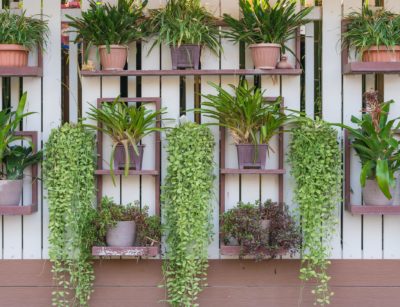
Gardening appeals to the very young, the very old, urban dwellers, country folk, and just about everyone! But for some of us, space can be an issue. For others, traditional in-ground gardening has exhausted its novelty. If you’re looking for something unique and exciting, or if you feel limited by a smaller yard, a vertical garden might be right up your alley.
Like a statement wall or a piece of art, vertical outdoor gardens add a great visual element to a space. These can be pre-bought or DYI’d for those who choose to embrace a more adventurous approach. This is an especially great trend for very small spaces and can add visual interest, character and a lasting impact. And for those living in close proximity to neighbors and/or noise pollution, a vertical garden such as a living wall can add privacy and block excess noise.
Let these ideas might spark your imagination as you transform your ideas of gardening from horizontal to vertical.
A hanging garden. Many of us have stopped to admire the hanging planters, overflowing with blooms, often uniformly displayed across wide country-style porches. But you can hang planters in any way that you wish. By varying their sizes and heights, you could create a changing “wall” of hanging planters that creates a secure cocoon around your patio or porch.
A vertical, edible garden. Vertical gardens don’t have to be decorative only. Plenty of foods can be grown in hanging pots, landscape fabric pouches, or a living wall. Imagine walking out onto the porch to snip your favorite herbs, grab a few lettuce leaves, or harvest fresh cherry tomatoes. It’s possible!
Succulents as artwork. Succulents grow very well in the vertical format, and there’s an enormous variety of species from which to choose. Vary colors and textures to create a vertical garden that serves as a living work of art.
Lattice as an affordable option. Simple, lattice-style woodwork can be purchased at home improvement stores, cut to fit your space, and installed even by amateurs. Next, choose a climbing vine and train it to grow up the lattice to create a cozy space. This project works for porches or to create nooks around swings and hammocks.
Upcycle your garden. Upcycled containers like painted tin cans can be fastened to a fence or wall, and make adorably quirky planters.
Decorate the side of your house or shed. Affix landscaping fabric pouches to the side of your house or a shed, and let your imagination run wild. Planting a mix of flowers, ferns, or climbing vines lends to an eclectic and wild ambiance.
For more landscaping tips and ideas, contact us. We can help you fit more plant life into smaller spaces around patios and porches, or renovate your entire yard if you prefer.

Gone are the days of simple playground structures being the talk of the block. In the coming year we will continue to see a focus on getting more creative with outdoor spaces, especially with regard to making these areas fun and useful for children. This is especially true considering the fact that kids are spending more time at home (and in the yard), and neighborhood families create “pods” of safe social interaction for children.
Sure, you could purchase a simple swingset from the nearest big box store, assemble it, and set the kids loose to play. But with a bit more creativity, you could create an outdoor space that continues to spark imagination and provides for a much greater range of activities. Zip lines, climbing walls, ninja warrior courses, and monkey bars set between trees will keep children busy and active.
As you design your outdoor play space, keep these ideas in mind.
Children’s ages. A play space that appeals to them now might quickly lose its appeal as the kids get older. Design spaces with growth in mind, so that they continue to feel interested and challenged.
Versatility. When you can, focus on utilizing elements that serve more than one purpose. For example, a volleyball court for older kids can also be used as a sandbox by younger ones. A simple patio can provide a space for chalk murals, hopscotch, roller skating, and more.
Reduce, reuse, recycle. As we increasingly pay attention to our own environmental impacts, the idea of reusing and recycling materials makes more sense than ever. Plus, you can save money, too! An old tire becomes a swing, tree stumps transform into an obstacle course, and scavenged playground equipment can be made new with a few repairs.
Their own little garden. Kids can learn a lot by watching plants grow. Consider setting aside space in your garden for them to plant their favorite flowers or grow their own food.
Consider down time, too. Bundles of energy that they are, even kids need down time. Consider a child-sized picnic table for enjoying meals outdoors, a cozy reading nook, or a relaxing hammock for naps in the shade.
This year, parents will continue to incorporate more environmental and natural play elements into the yard, in order to encourage investigation of the local natural environment. As you redesign your backyard, contact us to discuss your plans. We’ll be happy to help you turn your (and your children’s) dreams into reality!

Many of us are feeling a need for more outdoor time lately, and who couldn’t use a bit of self-therapy these days? Gardening provides for both of these needs, by encouraging you to spend more enjoyable and even meditative time outside. And luckily, gardening never gets boring, because new trends continuously emerge to keep us engaged.
Speaking of trends, we expect these five design trends to influence outdoor spaces this year.
More purposeful design. With regard to landscape design, many homeowners previously focused on the simple. They wanted something attractive, and often low maintenance, but otherwise did not spend too much time thinking about the usefulness of the space. All of that is set to change this year. With families spending more time outdoors, landscapes increasingly serve a multitude of purposes. Perhaps you dream of a patio for visiting with neighbors, a volleyball court for the kids, or a relaxing hammock by the pool. The usefulness of outdoor features is now more important than ever.
Living rooms expanding into the backyard. Spending more time at home doesn’t have to mean spending time inside the home. Homeowners now wish to enjoy a more seamless transition from the living room to the backyard, with activities such as outdoor movie screenings becoming more popular. Landscape features such as outdoor lighting, seating areas, speakers, and inflatable TV screens are in demand now.
Peace and serenity. Very manicured and uniform landscapes are pretty, but homeowners are looking for something different right now. Lush, enveloping landscapes are in, as homeowners seek an outdoor environment that makes them feel cocooned in safety and privacy. Lush evergreen hedges, wild, unmanicured hydrangeas, and soothing colors lend a soothing ambiance to backyards that would otherwise feel exposed or overly plain.
A return to native plants. As more of us turn our attention to the environmental impacts of our actions, we are realizing the importance of using native plants in the landscape. Using species native to your area usually translates to lower water usage, and their care is simpler as well. Native species also provide habitats to local wildlife, and attract beneficial pollinators to the garden.
Do any of these up-and-coming trends appeal to your idea of the perfect landscape? Give us a call to discuss them in more detail, and we will help you redesign your outdoor space to perfectly suit your needs.
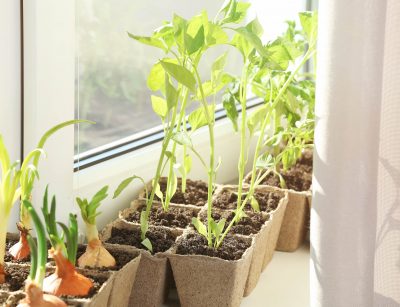
Throughout 2020, home gardening exploded in popularity throughout the country. Our 42 million gardeners swelled to 63 million within the span of a year, and there are no signs of the trend reversing. In fact, most home gardeners report that they want to go bigger and better in 2021!
Whenever a hobby enjoys sudden, increased popularity, we can expect new trends to emerge. In 2021, these are the trends to watch.
Victory gardens. From grocery store produce shortages, to rising prices or fears of shopping in public, plenty of reasons are prompting home gardeners to grow more food at home. The trend of “victory gardens” began in World War Two, when the general public supported the strained food supply chains by planting their own vegetable crops. Now, of course, a pandemic was the precipitating force for this trend, but the end goal is the same. Americans want access to fresh, local food, and they want to pitch in and help everyone to avoid shortages.
More outdoor living. It’s certainly easier to “socially distance” when you’re outdoors! As more of us work from home, or simply avoid going out in public very often, we’re supporting our need for fresh air and sunshine by hanging out in the yard. Of course, that means beautifying our outdoor spaces and making them more enjoyable to use. Home gardeners are adding privacy hedges, installing fire pits, planting more flowers, or even installing fish ponds or swimming pools.
A focus on bold color. Who couldn’t use a bit of cheering up at this time? Bright, tropical plants are enjoying a surge in demand, as gardeners seek to brighten up the mood of their landscapes. When utilized in large pots, tropical plants can be moved indoors for the winter, where they continue to add a festive flair to the home.
Houseplants. Speaking of bringing plants indoors, houseplants are enjoying their moment in the spotlight, too. Remote workers have discovered that the simple addition of a few plants can reinvigorate a tired workspace. Even kids who are learning from home have picked up a new hobby, and tending a houseplant can provide a valuable learning activity.
You might have noticed that these four trends truly span the entire spectrum of home gardening. 2021 might just be the year of the plants! For assistance with landscaping projects, give us a call to discuss your plans.



When it comes to gardening, most of the “fun stuff” tends to happen during spring and summer. But that doesn’t mean you can’t enjoy some time in the garden right now! In fact, planning and preparing throughout the cooler season can lead to a more productive and beautiful garden later in the year.
Build raised beds. Raised beds can offer the easiest way to control soil conditions and prevent excess weeds. If you’re hoping to expand your vegetable or flower gardens in the spring, start building raised beds now.
Hardscaping. What’s a garden without a pebble pathway or stepping stones? Complete your hardscaping projects now, so that you can enjoy more time digging in the dirt when spring rolls around.
Make newspaper plant pots. Put together newspaper plant pots now, and start your seeds in them. When you transplant your seedlings in the spring, the newspaper will break down in the garden. Planting has never been easier!
Plant bare-root strawberries. Bare-root strawberries should be planted in late winter, especially in milder climates like Southern California. This is the cheaper way to start a plot of strawberries, and getting started earlier can ensure a more bountiful crop of berries.
Build a birdhouse. Build a birdhouse now, and your feathered friends will move in by spring. If you’re lucky, you can enjoy the cheeps and chirps of new baby birds in a few months!
Plan a cool season garden. Now is the time to begin planning for lettuces, spinach, kale, carrots, parsnips, and other cool season veggies. If you time it right, you can harvest your cool season crops as you plant your warm season veggies, making maximum use of your garden space.
Organize a seed swap. Get together with friends, and trade out seeds that you won’t be using this year. This is the perfect way to obtain interesting new varieties for your garden, and to connect with like-minded hobbyists.
Plan for spring. And of course, the most important thing to do right now is plan for spring. Plants do best when their space, light, and watering needs are considered before planting. So grab a pen and paper, draw a diagram of your space, and get to work. And don’t forget that we’re here to consult with you, if you need help installing a new bed or landscaping feature.


Spring is just around the corner, and for rose enthusiasts, that means your planning sessions are now in full bloom. As you prepare your garden for a busy growing season, you’re probably considering an addition of one or more new varieties of roses. We don’t blame you; roses can be addictive! As you continue planning, you might consider one of these five popular roses varieties.
Sweet Spirit. This bloom was recently a Regional Choice Award Winner in all regions and Fragrance Award Winner. These fully double, traditional rose blooms boast a strong, sweet fragrance. They grow well in hot climates, making the Sweet Spirit a terrific choice for Southern California.
Brick House. Brick House was a Regional Choice Award Winner in the Northwest, Northeast, and South-Central regions. But have no worries; you can cultivate this lovely variety in Southern California, too. This strong, dark red rose variety will bloom throughout the season, keeping your garden bright and beautiful for months. Since it’s highly disease resistant, the Brick House might be an excellent choice if you’ve struggled with this problem in the past.
Petite Knock-Out rose. If you enjoy roses but need something to fit a more compact space, Petite Knock-Out roses are just what you need. These petite rose bushes grow to about 18 inches tall, and feature bright red flowers on top of glossy, dark green foliage. This variety is also extremely spot resistant, making it the perfect choice for gardeners who desire a lower maintenance rose.
Romantica roses. If you’re looking for something dramatic, Romantica roses might fit the bill. These old-fashioned blooms possess a strong fragrance, but were designed to be more disease resistant. Bred in Southern France, Romantica roses are available in a variety of types and colors, and all fit in well with a more modern landscape.
Eyeconic roses. These hardy roses re-bloom throughout the season, and exhibit their distinct “blotch” characteristic throughout all stages of flowering. If you’re looking for something unique, check out the four different varieties of eyeconic roses which are available in several distinct colors.
All of the rose varieties described above are available through Star Roses and Plants. If you need assistance designing your rose garden or installing a new landscape feature, give us a call and we’ll be happy to offer our expertise.
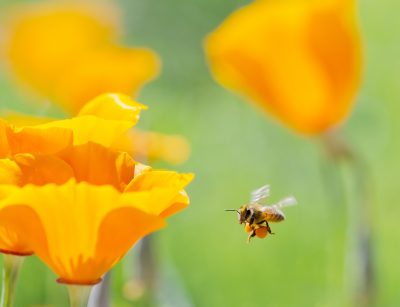

Each January, Pantone releases their “color of the year”, sparking a year of inspiration for enthusiasts of both fashion and interior design. The selection process involves careful consideration of trends, both current and emerging, and reflects all areas of design, entertainment, technology, and even current events.
For 2021, Pantone actually decided to release a pairing of shades: Ultimate Gray and Illuminating (a breezy, bright yellow).
After the turbulence of 2020, Pantone apparently felt that this marriage of two shades reflected the qualities we most need right now. As the company states on their website,
“As people look for ways to fortify themselves with energy, clarity, and hope to overcome the continuing uncertainty, spirited and emboldening shades satisfy our quest for vitality. PANTONE 13-0647 Illuminating is a bright and cheerful yellow sparkling with vivacity, a warming yellow shade imbued with solar power. PANTONE 17-5104 Ultimate Gray is emblematic of solid and dependable elements which are everlasting and provide a firm foundation. The colors of pebbles on the beach and natural elements whose weathered appearance highlights an ability to stand the test of time, Ultimate Gray quietly assures, encouraging feelings of composure, steadiness and resilience.”
You will see these shades emerge everywhere from fashion’s runways to your local hardware store throughout the year. If you’re looking for an on-trend style update for your home’s exterior, consider new cushions for outdoor furniture that incorporate these shades, gray or yellow flower pots and other containers, and pops of cheery yellow flowers for your garden. Perhaps you’d even like to redesign your mailbox garden or install a new relaxation spot out back.
For help with your landscape redesign, give us a call. We will help you turn your vision into reality, incorporating both classic design staples and up-and-coming trends.
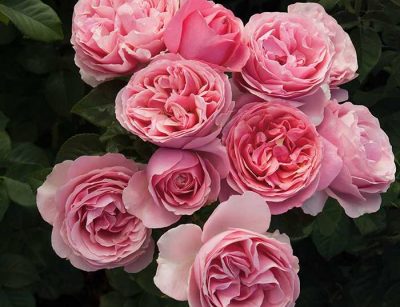

We don’t tend to think of winter as peak gardening time. But there are actually plenty of tasks you should be performing at this time, in order to ensure a healthy and thriving garden this summer. The following six tips will help you rejuvenate your rose garden now, so that you’ll enjoy plenty of beautiful blooms later in the year.
Clear the garden of debris. Clean up any fallen leaves from your rose garden, especially leaves that have dropped off the roses themselves. Fungal diseases can flourish throughout the winter if you leave debris to “feed” them over the winter. Don’t place discarded rose leaves in your compost bin, either; you’ll just contribute to fungal spread throughout your entire garden.
Remove any rose bushes that seemed sickly last year. Bushes that appeared unhealthy might be carrying disease. If your efforts to save them didn’t work out over the summer, remove them now to prevent potential spread of any health problems.
Reduce height of overgrown rose bushes. Overly tall rose bushes can sustain wind damage over the winter. Reduce their height by one third to prevent this.
Apply a dormant spray. If you haven’t already, now is the time to apply a dormant spray on your rose bushes. A spray such as lime sulfur, used in the dormant season, can help ensure that you start off the growing season free of fungal diseases.
Mulch around roses, if you haven’t already. Mound up mulch at the base of rose bushes to help them retain moisture and discourage weeds.
Plan for new additions. New rose varieties are being released now. Check out a catalog or browse local nurseries to make your selections for new plantings. Planting begins in early spring so now is the time to plan!
If you need any help planning your rose garden, give us a call. We can help you decide which varieties work best in your existing landscape, or help you plan a new garden installation.
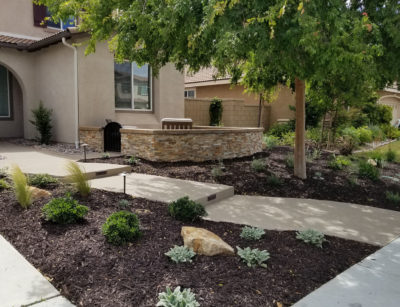

For a long time, we viewed front yards as something boring and uniform to maintain, while all the fun happened in backyards. But these days most of us prefer to beautify the front lawn, too. Plus, we can take advantage of the additional space, turning the front lawn into yet another place to enjoy outdoor time with the family or neighbors.
These ideas can help you merge form with function, adding curb appeal while increasing your enjoyment of the front yard.
Add a patio. Playing in the front yard is the best way to attract neighbors over to join in the fun. Add a patio, and now the adults have a spot to hang out and supervise. Bricks, pavers, or colored or stamped concrete offer plenty of versatility, so that you can design a patio that adds beauty to the front of your home.
Invite guests with a pathway. A pathway from sidewalk or driveway to the front door adds a decorative touch to the front lawn, while saving you from unappealing bare spots due to frequent trodding across the grass.
Change out your lawn. Increasingly, more homeowners are ditching the plain grass lawn for something more interesting. A xeriscape requires little to no maintenance, especially with regard to water, and can beautifully complement your home’s exterior. Other ground cover options, like creeping thyme, add both a pleasant scent and color. Many ground cover alternatives require less frequent or zero mowing.
Plant a row of festive roses. If you have problems with uninvited kids or pets frequenting your lawn, encourage them to stick to the sidewalk by planting a row of rose bushes. They look festive and add color, but politely serve your motivations.
Add pilasters and lights. The simple addition of pilasters will dramatically change your entryway. Include lights, and now the exterior of your home is much safer for visitors.
Build a privacy wall. Enclose a space with a privacy wall, and enjoy a cozy courtyard. This space can serve multiple uses, and it will be fun to decorate with potted plants or a fountain.
If any of these ideas appeal to you, give us a call. We will help you design an addition that lends both form and function to the front of your home.
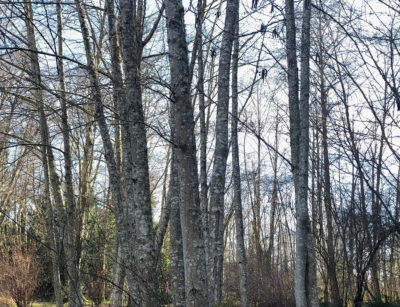

If you purchased a home this year, you are probably still learning about the yard. Each season, your gardens, lawn, and trees will change, and bring up new questions. In fact, it can take about a year or so before most new homeowners feel comfortable with lawn and garden maintenance.
In particular, you might be feeling a bit worried about your trees right now. Once some trees shed all of their leaves in the fall, they enter a dormant stage that is not only less attractive, but can actually give you the impression that they’ve died.
In most cases, this is totally normal. Deciduous trees, like oaks, maples, and many more, experience this pattern every year. In a few months, beginning in early spring, you will be relieved to see brand new leaf buds appearing on the branches of these trees. But yes, right now they might look “dead” compared to evergreen trees like pines, which stay green all year because they do not shed their leaves.
If you’re still feeling worried, there are a few ways to give your deciduous trees a quick “check up”.
Do a scratch test. Using a sharp knife (or a fingernail), scratch a piece of bark away from a branch. The tissue inside should be firm and green on the inside. Dampness is a good sign, whereas severe dryness is not. Stems that are brittle and crack easily are usually dead.
Examine your tree for signs of rot or decay. Sometimes these signs are fairly obvious, especially if the tree has been dead for a while. In other cases you might only find small decaying spots, or signs of rot only after peeling away a bit of the bark.
Check for mushrooms. Mushrooms around the base of a tree are often a sign of death, since mushrooms tend to grow on decaying matter.
If you’ve checked your tree and suspect that it is dead, call a certified arborist (tree company) soon. A dead tree can pose numerous risks, from fire to falling to attracting termites. Dead trees should be removed promptly in order to protect your home.
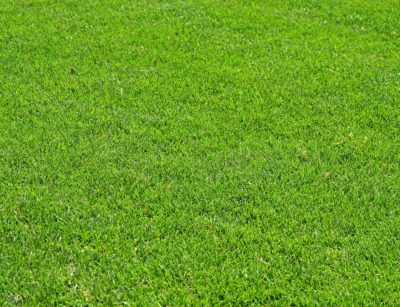

As we transition into winter, lawns composed of Bermuda grass will become dormant. Here’s what that means for you, and what you need to know about lawn care from now until spring.
No, you don’t need to mow. Once your grass goes dormant, it shouldn’t grow and you won’t need to mow the lawn. However, some homeowners find that they prefer to trim edges and uneven spots on occasion.
For your last mow of the growing season, it can be a good idea to leave the clippings on the lawn instead of removing them. The nutrients will then be recycled back into the lawn.
Cut back on watering. Because the growth cycle has ended, your Bermuda grass needs less water than before. Watering once or twice per month should be sufficient (and you can even skip that if it rains a significant amount). Any time the weather becomes unusually warm or windy, which can happen in more temperate climates, schedule an additional watering to prevent dessication.
What about seeding? Bermuda grass turns brown in the winter, but don’t worry. That doesn’t mean your lawn has died! Some homeowners mistakenly believe they now need to seed their entire lawn in order to replace the grass. Rest assured that this brown hue is normal, and that your Bermuda grass will turn green once again in the spring.
You don’t need to seed at all during this time. However, those who prefer a green lawn year-round can overseed with a perennial ryegrass. This grass will take over during winter months, but then go dormant in the spring when Bermuda grass takes over.
If you do choose to seed with another grass, keep in mind that you are signing up for maintenance rather than enjoying a dormant season and time off from this chore.
What about fertilizer? Bermuda grass should be fertilized in October, and then left alone over the winter. You won’t have to worry about fertilizing the lawn again until March or April.
And that’s really all there is to it! But if you have more questions about winter care for your lawn, call us and we’ll be happy to answer your questions.
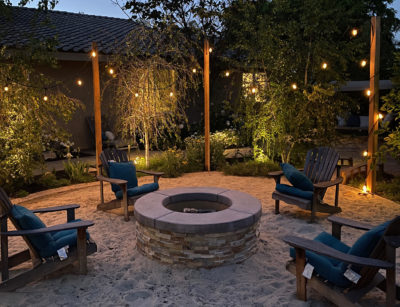

Spending time outdoors is good for all of us. Yes, even in winter! As you soak up sunshine, you can support your immune system as your body responds by generating vitamin D. Plus, fresh air and natural light boosts your mood.
But for those reluctant to spend time outside when the weather turns cooler, creating a cozy outdoor space can help. These ideas can transition your yard and patio from summer to winter, and help you enjoy your yard all year long.
Add a heater. Portable patio heaters are easy to set up, and are the most obvious solution for your cold-weather blues. And you might be amazed at how much heat they can provide.
Fire up the grill. Barbecuing isn’t just for the summer months. Move your grill a bit closer to the seating area – or vice versa – and the extra heat can help you stay warm. Try a few winter-themed recipes, like pairing grilled turkey with seasonal veggies.
Or, just install a fire pit. A fire pit serves as both a heat source and a conversation starter. Gather the family around the fire to tell stories and roast marshmallows.
Add outdoor entertainment. An outdoor movie screen or sound system can help you entertain the whole family, or just catch up on the evening news in a relaxing environment.
Bask in a hot tub. Those who miss soaking in the swimming pool might appreciate the soothing warmth of a hot tub. It’s fun for the whole family, or put the kids to bed and enjoy a late “date night” with your spouse.
Cover up. Adding a patio cover can help to retain a bit of heat, and keeps the rain out. What is more soothing than relaxing on the back porch, a cup of coffee in hand, listening to a soft drizzle?
Decorate for the season. Finally, don’t forget to decorate your cozy outdoor oasis. Add seasonal decorations and pops of color with new cushions, throw pillows, cool-weather flowers, and wreaths. A string of lights makes everything more festive.
To discuss any of these ideas, give us a call. We can help you design and install fire pits, outdoor kitchens, and other fun features that enhance the enjoyment of your home while blending seamlessly with existing aesthetics.
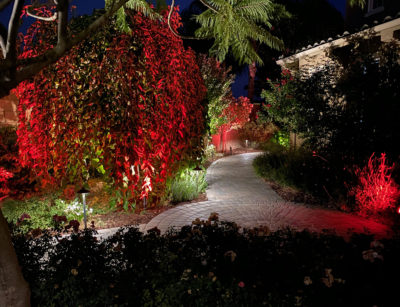

If you’re considering outdoor lighting for your home, you might be excited to learn about color-changing Bluetooth LED lights. For that matter, those of you with plain white lights might start to feel a bit envious after reading this blog!
These lights boast all the same features as regular LED lights, but with the added benefits of different colors. You can use these lights to add festive cheer to your home’s exterior, reflect the season, or even raise awareness for a cause. For example, you can program your exterior lights in the following ways…
● Red, white, and blue for the Fourth of July, election day, Memorial Day, or other patriotic events
● Purple and orange for Halloween
● Red, yellow, and orange (harvest colors) for Thanksgiving
● Red and green for Christmas
● Red for Valentine’s Day
● Green for spring celebrations
● Pink or blue to celebrate a new baby
● Special colors to represent local causes or fundraisers
● A family member’s favorite color on their birthday
● Or just change it up regularly for fun
All-brass path lights and uplights are the same high quality you’ve come to expect from our outdoor lighting, but now with the added upgrade of Bluetooth technology. Whether you change your colors hourly, nightly, or just a few times per year, it only takes a few seconds to program your lights. Using an app within your smartphone, you can adjust your lights at the touch of a finger, selecting from features such as brightness and a full color spectrum.
For more information on color-changing Bluetooth LED lights, give us a call. We’ll be happy to demonstrate the technology for you, so that you can decide if this type of outdoor lighting is right for your home.
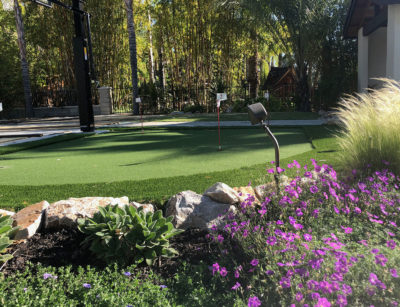

Quite a few of us work from home now… Why not “vacation” from home, too? At the very least, you can enjoy one of your favorite outdoor activities in the privacy of your own backyard, and skip the hassle of driving to the club. Install your own putting green, and you can golf whenever you want!
How big do you want it? Your putting green will, of course, be limited by the size of your yard. But if you have a large yard, you’re working with quite a bit of space. Think ahead to the future, and ask yourself if you might want to add other elements someday. If a pool, playground, or outdoor kitchen is a possibility, perhaps you don’t want to cover every square inch with a putting green.
Adults-only or family activity? Do you have kids or grandkids? Or might you have them someday? There’s nothing wrong with adults-only spaces either way. But if you’d like to include the children in your golf space, consider putting spaces designed especially for them. Elements that are fun for kids can make whimsical additions for adults, too.
Positioning your green. A professional landscape designer will work with your land’s natural features, to incorporate the elements you want in a way that doesn’t create unnatural water flow or other disturbances. Tee boxes can be strategically placed to take advantage of multiple holes, so that you can fit an entire mini-course into a backyard.
How much rise and fall? Generally speaking, you will want a level or near-level spot for your backyard putting green. While it is possible to build into the side of a hill, doing so can sometimes create drainage issues and other problems. Your course can be designed to incorporate slight natural rises and dips, but save the seriously challenging stuff for the pro courses.
Fringe or no fringe? Fringe adds a professional touch, and looks great too. Of course, it’s one more thing to maintain, so the choice is up to you.
Consider drainage. Without proper drainage, your dream putting green could become a nightmare mini-swamp. Four-inch perforated drainage pipe, laid in a trench underneath your green, is considered industry standard.
Artificial turf or natural grass? Artificial turf is low maintenance, but it’s not “no maintenance”. You will still need to clean it regularly, and brush it to “fluff” it up. As for natural grass, keep in mind that mowing to ⅛ inch is standard practice for putting greens. Natural grass will require more maintenance, but some golfers do prefer it.
Landscape around your green. The landscaping around your putting green can be as natural or as elaborate as you like. The idea is to help the green blend with the rest of your backyard, and any other elements that you want to include. Remember to avoid planting trees or messy shrubs near the green, as they will continually annoy you by dropping leaves or flowers onto your recreation space.
Give us a call to discuss your ideas, and we can help you to design a backyard putting green that suits your needs while complementing the exterior of your home.
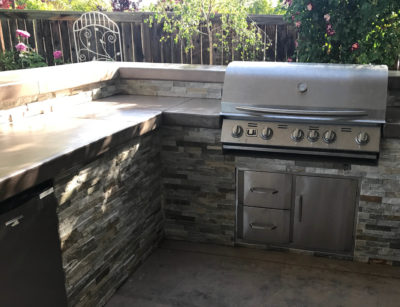

Who doesn’t love a good, old-fashioned barbecue? But if your family is getting tired of burgers and hot dogs, you can still enjoy outdoor meals and fun together. Check out these creative meal ideas – all of which can be prepared outdoors on your grill!
Grilled pizza. Grilling pizza is a bit of an art form, but it doesn’t take long to get the hang of it. No, your dough won’t fall through the grill, as long as you’ve preheated properly. Place plain dough on a hot grill, cook for a few minutes, and then flip it. Now place your toppings and finish cooking your pizza.
As you might imagine, smaller pizzas are easier to grill. Provide a “toppings bar” and let everyone put together their own mini-pizzas.
Roasted veggies. When it comes to grilling vegetables, you can go so much farther than corn on the cob. Yes, you can place just about any vegetable right on the grill, just as you do meat. Try onions, bell peppers, asparagus, squash, eggplant, mushrooms, tomatoes, and anything else that strikes your fancy.
When prepping veggies, remember to keep their surface area large, so that they don’t fall through the grate. Brush each vegetable with olive oil to prevent sticking, and sprinkle with lemon juice, herbs, or spices if desired.
Bake bread. When the lid of your barbecue is closed, it essentially becomes an oven. So yes, you can bake bread outside! As your barbecue approaches 450 to 500 degrees, place a pizza stone or large cast iron pot on the grill, close the lid, and allow the stone or pot to heat for about 15 minutes.
Then, just plop your dough onto the stone or into the pot. It’s that simple! Some people prefer to toss a handful of corn meal onto the cooking surface first.
Bake for about 30 minutes, monitoring the temperature of your barbecue and the bread. If you use a bread thermometer, bake until the bread reaches 210 degrees on the inside, then remove the stone or pot from the grill.
Thanksgiving on the barbie. Many of us will be hosting outdoor Thanksgiving dinners this year. Why not fire up the barbecue? Yes, it’s possible to grill or smoke an entire turkey; just make sure the internal temperature reaches 165 degrees to ensure doneness.
As for side dishes, all you need to do is heat up one section or burner of the grill, place the food away from the direct flame, and close the lid. Your barbecue functions like an oven this way, and you can cook entire casseroles outdoors!
You still have time to design the outdoor kitchen of your dreams. Give us a call, and we can help you decide on the right elements and the perfect look for your culinary recreation space.
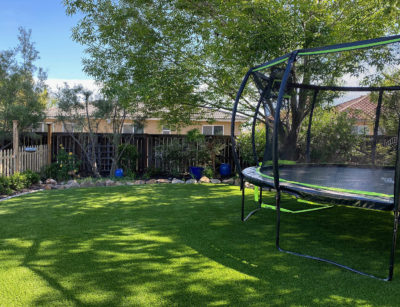

So, you’ve decided to go with artificial turf. It’s attractive, it’s uniform in appearance, and it’s lower maintenance… But wait. It’s not completely maintenance free!
That’s right. While artificial turf carries many benefits, including the fact that it’s easier to maintain than a grass lawn, you actually can’t just install it and forget it. Artificial turf will require some care to keep it looking (and even smelling) its best.
Dealing with weeds. You might be surprised to discover that weeds can invade artificial turf lawns, too. They’re usually much more sparse, but weeds can and do pop up through the backing. But if you pull them up, the way you might on a grass lawn, you risk uprooting the turf around it.
Instead, weeds in an artificial turf lawn must be sprayed with a water-based herbicide.
Remove debris. No, you don’t have to mow the lawn anymore, but you still have to clean it up. Excess debris can clog the drainage system, and lead to more weeds in your lawn. Remove leaves or branches as needed, either by hand or with a leaf blower.
During “high pollen” times, you should rinse your turf with water, especially if you suffer from allergies.
“Brush” your grass. Artificial turf can become matted and lose its uniform appearance in high-traffic areas. About once per week or so, brush or rake those areas against the grain to keep it looking fresh and fluffy. Just make sure to use a rake with synthetic or plastic bristles, rather than metal ones.
Avoid stains. Some items can leave frustrating, stubborn stains on your turf. Prevention is your best “medicine” here. Keep motor oil, suntan oil, cooking grease, wine, colored sodas, and other common stain culprits away from your yard. But when spills do happen, follow these steps:
● Clean up quickly, since stains are best removed before they set
● Blot the liquid with a dry towel or even kitty litter
● Rinse the turf with water and a mild detergent
● For stronger stains, use a solution of 3 percent ammonia in water
● Use mineral spirits on the toughest stains
● Always thoroughly rinse the area after cleaning
Tree sap and chewing gum can present a sticky challenge. For these accidents, use dry ice or aerosol refrigerants to freeze the material, then scrape it off your turf.
Clean up pet messes. If you allow solid waste to dry, it can be easier to remove. Urine can be simply washed away.
Artificial turf generally lasts between 15 to 25 years. Care for yours appropriately, and you can probably reach the longer end of that spectrum. Contact us if you have any other questions about caring for artificial turf, or if you’re considering an installation. We can help you decide if this type of lawn is right for you.
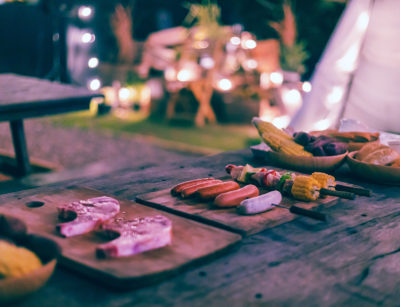

For many of us, the cancellation of summer vacations came as a disappointment this year. But quickly, many caught on to a brand new trend. The rise of the yardcation, and even backyard camping, has brought many of us back to our roots. We’re discovering that family fun can be simple and inexpensive, and you don’t need to venture very far from home!
The rise of outdoor dining. Many of us are feeling wary of restaurant dining this year, but boredom has begun to gnaw at us. The solution might lie in your own backyard; add a dining table to the patio, and now your meals take on a festive new flair.
But you don’t have to stop at simply eating outdoors. A barbecue grill allows you to cook entire meals from start to finish, whereas a fire pit offers fun memories of roasting marshmallows and making s’ mores with the whole family. Why stop there? A wood-fired pizza oven provides another fun option for backyard dinners. A drink cooler or cocktail prep area makes it easy for adults to keep their favorite refreshments on hand.
All of these options feel like camping, but there’s no need to load down the minivan with equipment and sleeping bags, travel far from home, line up a sitter for house pets, or search for a bathroom in the woods.
Backyard camping is fun and convenient. Of course, you can always camp in the backyard, too. Add a few hammocks and bring a blanket, and the whole family can snuggle up outdoors. String lighting or a few solar lanterns add a festive touch and help you find your way inside to the bathroom when necessary. And if you’re really feeling adventurous, go ahead and set up an actual tent!
Fun for the whole family. Younger kids and even adults find backyard camping to be a fun, creative, and easy way to enjoy more family time outdoors… But what about teens? They can be a tad more difficult to convince, but an outdoor movie screen often does the trick. This idea can range from simple (a bedsheet hung between trees or on a fence line) or complex (an inflatable screen and impressive sound system). Enlist their help constructing a playlist for dinner music, or arrange for a game of laser tag in the dark.
Yardcations can be as simple or as complicated as you wish, but often these outings do revolve around food. If you need help designing an outdoor kitchen or patio space, call us to discuss your plans. We can help you design a space that works for your family’s needs as well as your budget.
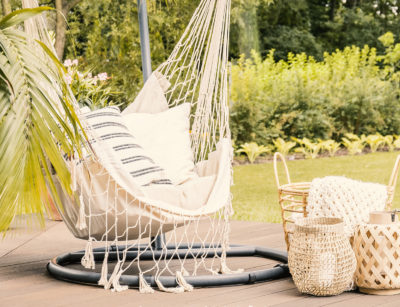

When you think of spending time outdoors, you might envision hiking, swimming, and outdoor sports. Maybe you picture the kids playing on a swing set, or yourself digging in your vegetable garden. All of these activities focus on action and exercise. While these are important (and healthy) concepts, without a doubt, there are other ways to spend time outdoors and enjoy the benefits of improved mental health and even boost immunity.
That’s the idea behind the rise of the “Zen Den”; a place where you can spend time outdoors, soak up some fresh air and sunlight, and reconnect with nature. We know that spending just 17 minutes per day outdoors can significantly boost feelings of happiness and well being, but those minutes don’t necessarily have to involve exercise or yard work. If relaxation is more your speed, check out these ideas for creating your own Zen Den.
Focus on serenity. Noise and commotion might serve as the first obstacle to creating a zen space. Therefore, some of your most important changes might involve noise-blocking landscaping. Options include fencing, living walls, rows of dense shrubbery, or water features such as fountains or waterfalls. You might be surprised at the difference one noise-canceling addition can make!
Determine how you wish to use the space. A hammock or swing offers a place to read and relax. On the other hand, if your vision involves small gatherings, a fire pit or conversation area might be in order.
Are you hoping for a quiet space to practice yoga or meditation? Remember to reserve a flat, grassy spot away from the main activity areas.
The presence of a children’s play area doesn’t necessarily distract from your relaxation zone. Place play equipment on the opposite side of the yard, and select structures that blend with the landscape rather than distract from it. Natural materials are preferred over bright, colorful plastic. Work with the landscape, using tree rounds as steps or embedding a slide into a hill. Options such as a sandbox or play table encourage more stationary play (but still plenty of fun).
Consider a “no-phone zone”. Consider making your outdoor space a “no-phone” zone, whether by friendly suggestion (a cute sign) or an outright edict directed at the kids. A Zen Den encourages all of us to look away from the screen and out toward the world around us, but some might need a gentle reminder to enjoy all that life has to offer.
For more input on renovating your backyard, call us to discuss your plans. We can offer suggestions on blocking noise, adding desirable elements, and more to turn your backyard into the relaxing oasis of your dreams.
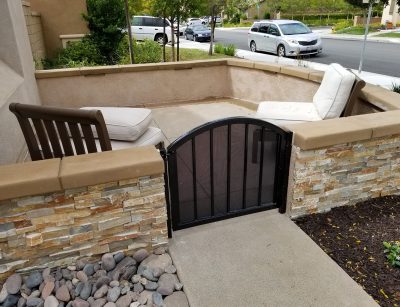

We can all remember a time in which front yards were strictly dedicated to curb appeal, with all the action happening in backyards. Driving through most urban and suburban neighborhoods, you almost wouldn’t guess that actual people lived in many of those homes! Rows of houses appeared like movie sets, with the entire family gone to work or school all day.
If 2020 has brought us unhappy surprises, plenty of silver lining has been delivered along with those. As the way we live and work shifts, we’re seeing new trends trickle down into landscape design. And one of those trends is particularly surprising: Homeowners no longer prefer the perfect, manicured movie-set front lawn. Instead, a focus on community is emerging.
Now, with the family home more often, homes are not simply a place to escape the world and sleep at the end of the day. Front yards are being transformed to encourage more interaction with neighbors, with popular elements including:
Patio spaces. Rather than keeping to themselves, homeowners are feeling more eager to entertain. A front yard patio provides a place to enjoy conversation and after-dinner drinks, or wave to passing neighbors as they enjoy their nightly stroll.
Vegetable gardens. The front yard is just as good a spot for the veggies as the backyard. But out front, gardeners can benefit from interaction with neighbors as they work. And now that organic home gardening has become a trend, a vegetable garden in the front yard makes a statement about the homeowner’s values and personality.
Playspaces. Who says kids must be sequestered in the backyard? Front yard play spaces almost beg other children to join in the fun. As distance learning and homeschooling continue to rise, new opportunities for socialization become more important than ever.
The renovation of the front yard can be complicated or relatively simple; anything from the addition of a few rocking chairs to a giant portable movie screen and sound system can be accomplished. For more information on transforming your yard into a more social community space, give us a call. We will discuss your ideas and then help you turn your vision into reality.


During both World Wars, homeowners across the US and other countries planted “victory gardens”. The idea was to grow more food close to home, in order to free up food supplies for the war effort. For many, that habit stuck.
Millennials grew up hearing their grandparents talk about gardening, and for a long time, it seemed as though home vegetable gardens had become a relic of the past. Perhaps younger generations viewed gardening as something only “old people” did. But now, that viewpoint is fading, with Millennials now comprising nearly a third of home gardeners.
Of course, a Millennial’s garden looks a bit different from their grandparents’ hobby. Putting their own spin on it, Millennials are more likely to focus on…
Smaller gardens. With gardening seen as less of a necessity and more of a fun way to produce local organic food, Millennial gardens tend to be smaller and more focused around a few favorite foods. In smaller urban backyards Millennials might use horse troughs or whiskey barrels as planters, or taller planter boxes to maximize vertical space.
A focus on organic food. Millennials are more likely to prefer organic growing methods, and therefore choose crops that grow easily in their geographical area without a lot of fuss. Pesticide use is limited or nonexistent, with many Millennials experimenting with other methods to deter insects and rodents.
Sustainability. Along with eschewing pesticides, Millennials might plant flowers specifically to attract pollinators to the garden. Some are going one step farther, adding beekeeping to their list of outdoor pursuits in an effort to help boost declining bee populations.
Low maintenance. Millennial households are more likely to be dual-income, with little spare time for household chores. Gardens are set up to be low maintenance, with a focus on raised beds, fruit trees, or simple potted herbs.
An emphasis on “foodie” trends. A millennial garden is likely to reflect trends in the “foodie” world, such as microgreens and kale, organic fruit trees, cocktail ingredients like herbs, or even hops gardens (for creating homemade craft beers).
Overall, Millennials still prefer multi-use spaces – room for kids to play, a perfect spot for entertaining, and a vegetable garden. Therefore, the garden might not make up the bulk of usable space in the yard but is still becoming a more lucrative feature.
For more information on adding a garden space or fruit trees in your yard, call us at McCabe Landscaping. We can help you with an easy landscape redesign that suits your needs and helps you achieve a low-maintenance but productive vegetable or herb garden.
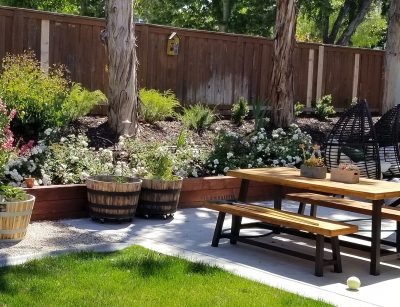

During times of rapid societal changes, we tend to see those effects spill over into design as well. In 2020 we’ve noticed quite a few exciting new trends, including the practice of “rewilding” our yards.
Rewilding is pretty much what it sounds like, but perhaps more organized than you might imagine. In the past, urban and suburban yards mostly involved an expanse of grassy lawn, a few well-chosen shrubs or flowers, and perhaps a decorative tree or two. But the look was fairly standard and could be quite uniform whether you were looking at a yard in Southern California or Eastern Virginia. Rewilding involves the idea of incorporating more natural plants into the yard so that it is not only more ecologically responsible but also reflects a more “local” look.
The ecological benefits of rewilding promise to reinvent the way we landscape our homes. When you select environmentally conscious species for your lawn and garden, you can
- Encourage critical pollinators like bees and butterflies (which are in danger in many areas)
- Promote biodiversity
- Use fewer resources, such as water, to support your landscape
For those of us in Southern California, that last point can be crucial. Low water species are already adapted to our climate, which can mean lower rainfall than many areas. By selecting water conscious species for our landscaping, we can ensure that we need less water to sustain our yards. Not only does that translate to savings on your water bill; you can help reduce the danger of drought for the entire region.
You’re not restricted to only native plants. Many species, not naturally found in our area, are climate-adapted to thrive well here. They can also perform well in a lower-water landscape, and don’t compete with local plant or animal species. Many plants from arid areas such as Australia and South Africa as well as the Mediterranean will thrive in California landscapes.
Rewilding might seem like a “trend” now, but time will tell. In decades to come, we might look back on this shift and thank ourselves for helping to save our local ecosystem. For more information on adding native or climate-adapted species to your landscape, call us to discuss new and exciting design options.
